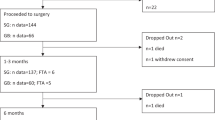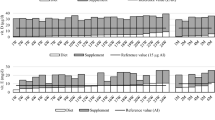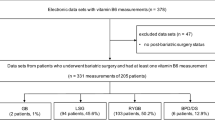Abstract
OBJECTIVE: To investigate homocysteine levels and their relationship with serum folate and vitamin B12 concentrations with weight loss after the Lap-Band® form of gastric restrictive surgery, with the view to minimizing risk.
METHODS: We measured levels of fasting plasma homocysteine (tHcy), folate (serum and RBC) and vitamin B12 in two groups. The study group was 293 consecutive patients at 12 (n=192) or 24 (n=101) months review after surgery. The controls were 244 consecutive patients presenting for this surgery.
RESULTS: The group losing weight had higher geometric mean tHcy levels: 10.4 (95% CI, 9.8–10.8) µmol/l compared with 9.2 (95% CI, 8.9–9.7) in controls (P<0.001). This occurred with higher folate levels and unchanged vitamin B12 levels. Levels of folate and B12 together explained 35% (r 2) of the homocysteine variance in the weight loss group compared with only 9% (r 2) in controls (P<0.001). Those taking regular multivitamin supplements had lower tHcy levels: 9.6 (9.1–10.0) µmol/l vs 12.3 (11.4–13.3) in those not taking supplements (P<0.001). A low normal plateau of tHcy levels occurred at levels of folate >15 ng/l and B12>600 ng/ml. A curvilinear relationship exists between these cofactors and tHcy levels, with the dose–response relationship shifted to the right in the weight loss group.
CONCLUSION: This study shows elevated tHcy levels with weight loss, without lower serum folate or vitamin B12 levels. There is an altered dose–response relationship with higher serum B12 and folate levels required to maintain recommended tHcy levels. Patients losing weight have significant health benefits; however, they may be at greater risk of vascular events or fetal abnormality in association with raised tHcy levels. Multivitamin supplementation is effective in lowering tHcy levels.
This is a preview of subscription content, access via your institution
Access options
Subscribe to this journal
Receive 12 print issues and online access
$259.00 per year
only $21.58 per issue
Buy this article
- Purchase on Springer Link
- Instant access to full article PDF
Prices may be subject to local taxes which are calculated during checkout



Similar content being viewed by others
References
Brolin R, Gorman R, Milgrim L, Kenler H . Multivitamin prophylaxis in the prevention of post-gastric bypass vitamin and mineral deficiencies Int J Obes Relat Metab Disord 1991 15: 661–667.
Crowley L, Seay J, Mullin G . Late effects of gastric bypass for obesity Am J Gastroenterol 1984 79: 850–860.
Amaral J, Thompson W, Cardwell M . Prospective hematological evaluation of gastric exclusion surgery for morbid obesity Ann Surg 1985 210: 186–193.
Sileo F, Bonassi U, Bolognin C . Bilopancreatic bypass in the treatment of severe obesity: long term clinical, nutritional and metabolic evaluation Minerva Gastroenterol e Dietol 1995 41: 149–155.
Halverson J . Metabolic risk of obesity surgery and long term follow-up Am J Clin Nutr 1992 55 (Suppl 2): 602S–605S.
Sumner A, Chin M, Abrahm J, Berry G, Gracely E, Allen R, Stabler S . Elevated methylmalonic acid and total homocysteine levels show high prevalence of vitamin B12 deficency after gastric surgery Ann Intern Med 1996 124: 469–476.
Welsh G, Loscalzo J . Mechanisms of disease: homocysteine and atherothrombosis New Engl J Med 1998 338: 1042–1050.
Mills J, Conley M . Folic acid to prevent neural tube defects: scientific advances and public health issues Curr Opin Obstet Gynecol 1996 8: 394–397.
Printen K, Halverson J . Hemic micronutrients following vertical banded gastroplasty Am Surg 1988 54: 267–268.
Borson-Chazot F, Harthe C, Teboul F, Labrousse F, Gaume C, Guadagnino L, Claustrat B, Berthezene F, Moulin P . Occurrence of hyperhomocysteinemia 1 y after gastroplasty for severe obesity J Clin Endocrinol Metab 1999 84: 541–545.
Henning B, Tepel M, Riezler R, Gillessen A, Doberauer C . Vitamin supplementation during weight reduction—favourable effect on homocysteine metabolism Res Exp Med 1998 198: 37–42.
WHO . Obesity: preventing and managing the global epidemic WHO: Geneva 1998.
O'Brien P, Brown W, Smith A, McMurrick P, Stephens M . Prospective study of a laparoscopically placed, adjustable gastric band in the treatment of morbid obesity Br J Surg 1999 86: 113–118.
Malinow M, Bostom A, Krauss R . Homocysteine, diet and cardiovascular disease: A statement for health care professionals from the nutrition committee, American Heart Association Circulation 1999 99: 178–182.
Mills J, McPartlin J, Kirke P, Lee Y, Conley M, Weir D, Scott J . Homocysteine metabolism in pregnancy complicated by neural-tube defects Lancet 1995 345: 149–151.
Selhub J . Homocysteine metabolism A Rev Nutr 1999 19: 217–246.
Lewis C, Pancharuniti N, Sauber H . Plasma folate adequacy as determined by homocysteine level Ann NY Acad Sci 1992 669: 360–362.
Stampfer M, Malinow M, Willett W et al. A prospective study of plasma homocysteine and risk of myocardial infarction in US physicians JAMA 1992 268: 877–881.
Al-Obaidi M, Stubbs P, Amersey R, Conroy R, Granam I, Noble M . Admission plasma homocysteine predicts long term mortality in patients presenting with acute coronary syndromes Circulation 1998 98 (Suppl 17): 5551.
Hodis H, Mack W, Selhub J, LaBree L, Selzer R, Liu C-R, Li Y, Kwong-Fu H, Lee Z, Liu C-H . Plasma homocysteine levels, multivitamin use, and subclinical atherosclerosis Circulation 1998 98 (Suppl 17): 6021.
Willinek W, Lennarz M, Dudek M, Ludwig M, Stumpe K . Serum homocysteine in the upper range of normal is an important and independent risk factor for carotid atherosclerosis in young to middle aged normotensives Circulation 1998 98 (Suppl 17): 1921.
den Heijer M, Kostor T, Blom H, Bos G, Briet E, Reitsma P, Vandenbroucke J, Rosendaal F . Homocysteine as a risk factor for deep-vein thrombosis New Engl J Med 1996 334: 759–762.
Bellamy M, McDowell I, Ramsay M, Brownlee M, Bones C, Newcombe R, Lewis M . Hyperhomocysteinemia after oral methionine load acutely impairs endothelial function in healthy adults Circulation 1998 98: 1848–1852.
Powers R, Evans R, Majors A, Ojimba J, Ness R, Crombleholme W, Roberts J . Plasma homocysteine concentration is increased in preeclampsia and is associated with evidence of endothelial activation Am J Obstet Gynecol 1998 179: 1605–1611.
Chambers J, Obeid O, McGregor A, Powell-Tuck J, Kooner J . The relationship between hyperhomocysteinaemia and endothelial dysfunction is concentration-dependent, and present even at physiological levels Circulation 1998 98 (Suppl 17): 1921.
Landgren F, Israelsson B, Lindgren A, Hultberg B, Andersson A, Brattstrom L . Plasma homocysteine in acute myocardial infarction: homocysteine lowering effect of folic acid J Intern Med 1995 237: 381–388.
Rimm E, Willett W, Hu F, Sampson L, Colditz G, Mason J, Hennekens C, Stampfer M . Folate and vitamin B6 from diet and supplements in relation to risk of coronary artery disease in women JAMA 1998 279: 359–564.
Walker M, Wannamethee G, Whincup P, Shaper A . Weight change and the risk of heart attack in middle-aged British men Int J Epidemiol 1995 24: 694–703.
MRC Vitamin Research Group . Prevention of neural tube defects: results of Medical Research Council Vitamin Study Lancet 1991 338: 131–137.
Mills J, Scott J, Kirke P, McPartlin J, Conley M, Weir D, Molloy A, Lee Y . Homocysteine and neural tube defects J Nutr 1996 126: 756–760.
Cuskelly G, McNulty H, Scott J . Effect on increasing dietary folate on red-cell folate: implications for prevention of neural tube defects Lancet 1996 347: 657–659.
Anonymous . Recommendation for the use of folic acid to reduce the number of cases of spina bifida and other neural tube defects MMWR Morb Mortal Wkly Rep 1992 41: 1–7.
Oakley GJ . Eat right and take a multivitamin New Engl J Med 1998 338: 1060–1061.
Vollset SE, Refsum H, Irgens LM, Emblem BM, Tverdal A, Gjessing HK, Monsen AL, Ueland PM . Plasma total homocysteine, pregnancy complications, and adverse pregnancy outcomes: the Hordaland Homocysteine study Am J Clin Nutr 2000 71: 962–968.
Brolin R, Leung M . Survey of vitamin and mineral supplementation after gastric bypass and bilopanceeatic diversion for morbid obesity Obes Surg 1999 9: 150–154.
Author information
Authors and Affiliations
Corresponding author
Rights and permissions
About this article
Cite this article
Dixon, J., Dixon, M. & O'Brien, P. Elevated homocysteine levels with weight loss after Lap-Band® surgery: higher folate and vitamin B12 levels required to maintain homocysteine level. Int J Obes 25, 219–227 (2001). https://doi.org/10.1038/sj.ijo.0801474
Received:
Revised:
Accepted:
Published:
Issue Date:
DOI: https://doi.org/10.1038/sj.ijo.0801474
Keywords
This article is cited by
-
Pregnancy After Bariatric Surgery: What Are the Risks and Benefits?
Current Surgery Reports (2023)
-
Supplementation Adherence and Outcomes Among Pregnant Women After Bariatric Surgery
Obesity Surgery (2019)
-
Cardiovascular Risk Profile in Mediterranean Patients Submitted to Bariatric Surgery and Intensive Lifestyle Intervention: Impact of Both Interventions After 1 Year of Follow-Up
Obesity Surgery (2015)
-
Determinants of Hyperhomocysteinemia After Gastric Bypass Surgery in Obese Subjects
Obesity Surgery (2011)
-
Decreased Serum Betaine Concentrations in Patients after Bariatric Surgery
Obesity Surgery (2011)



